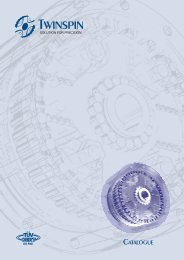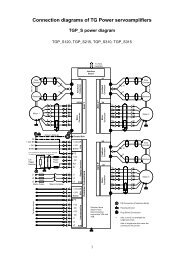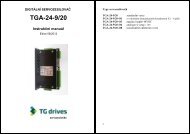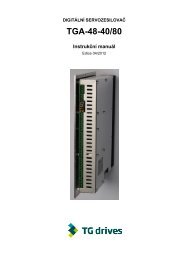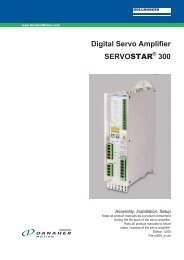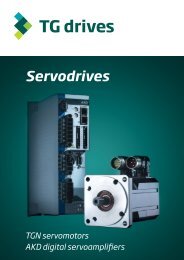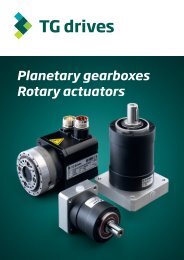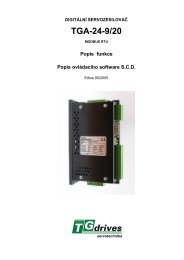Table of Contents - TG Drives
Table of Contents - TG Drives
Table of Contents - TG Drives
Create successful ePaper yourself
Turn your PDF publications into a flip-book with our unique Google optimized e-Paper software.
EXTENDED REGISTER GROUPS<br />
EEPROM<br />
Group Group<br />
No.<br />
Description<br />
EEprom 16 Non-volatile parameter storage.<br />
GENERAL<br />
EEprom<br />
The EEprom group has 128 registers. Each EEprom register is 32 bit wide. The<br />
registers EEprom.29, 63, 93, 127 are reserved for storage <strong>of</strong> partial checksums <strong>of</strong><br />
the data<br />
NOTE: At startup, the DMC 2 unit will always print the sign on text (and eventual<br />
error messages) at 9600 baud. The EEprom variables are then used to setup other<br />
addresses, etc. This is allows a standard terminal to be used to verify that the<br />
system is working properly. It also allows firmware errors to be reported prior to a<br />
system crash.<br />
The initial printout (done without enabling the interrupt system) may look something<br />
like this:<br />
1: DMC Ver 5.00<br />
2: ?FirmWare checksum error: SUM = xxxx<br />
3: <br />
If line 2: is printed, the System Firmware is damaged or the CPU board may be<br />
malfunctioning.<br />
If the cursor stops at instead <strong>of</strong> going to , the system locked (crashed)<br />
when the interrupt system was enabled.<br />
If only line 1 is printed and the cursor stops at position , the firmware checksum<br />
was ok but the system crashed when the interrupt system was initiated. If the<br />
cursor stops at , i.e. at the beginning <strong>of</strong> a new line, the problem may be one <strong>of</strong><br />
the following:<br />
A baud rate different from 9600 is setup by code in the EEprom.<br />
A baud rate different from 9600 is setup by auto starting PL-code.<br />
A comm-mode indicating computer mode, deselected unit, or x<strong>of</strong>f status bit set is<br />
setup in the EEprom.<br />
FUNCTION<br />
In the DMC 2 there is a 16 kbit serial EEprom which may be used for nonvolatile<br />
storage <strong>of</strong> application parameters. Some system parameters are taken from the<br />
EEprom at power up. Only 4 kbit are used for the 128 EEProm registers. The rest<br />
is used by the ParArea resource.<br />
At power up (reset), or when forced by the EEload statement, the contents <strong>of</strong> the<br />
EEprom device is read by the processor and put in RAM memory (in the EEprom<br />
register group). The consistency is checked using the checksum calculated at the<br />
previous storage.<br />
The EEstore statement forces a store procedure <strong>of</strong> the data in the EEprom group<br />
to the EEprom device.<br />
It is important to understand that when an EEProm register i read or written, it is<br />
affecting only the image held in RAM memory. To actually store the contents, an<br />
EEstore instruction has to be executed.<br />
User's Manual 5.1 Inmotion Technologies AB<br />
Doc. No.9032 0027 01 (B), Rev. 11.07.2001<br />
127



